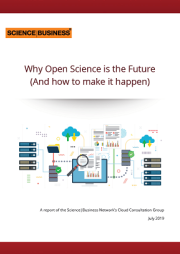A special report of the Science|Business Network
This report explores the case for open science, illustrated by use cases and case studies, spanning academia, start-ups and enterprises. It seeks to explain why public sector and private sector researchers should support open science by highlighting concrete examples of disciplinary breakthroughs that have been fuelled by the sharing of research data, tools and infrastructure.
Get your free copy

Around the world, researchers are increasingly aware of the value and importance of open science. As scientific research becomes highly data-driven and dependent on computing, scientists are conscious of the growing need to share data, software and infrastructure to reduce wasteful duplication and increase economies of scale. In an ideal world, every step of the research process would be public and transparent – the full methodology and all the tools used, as well as the data, would be accessible to the public and all groups without restriction, enabling reproducibility and refinement by other scientists.
Given the growing body of evidence that collaboration between scientists across the world can achieve breakthroughs far quicker than individual research teams, there should be strong momentum behind fully open science. But, in reality, progress is patchy. Worryingly, one online survey [1] in the autumn of 2018 found that only 11% of researchers shared data from their last project with people they don't know personally, down from 14% in 2016.
With some notable exceptions, the sharing of research data and tools occurs on a piecemeal basis, facilitate by trusted bilateral relationships, rather than through fully open platforms. Moreover, openness is not yet fully designed and embedded into the scientific process. Too often, research tools and data are opened up as an afterthought through a time consuming retrofit. Another major obstacle is the need to support the long-term preservation of research data and the software code, tools and operating environments required to make sense of the data. Depending on the discipline, important datasets can still yield scientific breakthroughs decades after they were first generated.
The European Open Science Cloud (EOSC) is seeking to make it much easier for researchers to pursue fully open science by federating the myriad of research infrastructures, tools and datasets being employed by the 1.7 million researchers across the EU. If it can pool Europe’s research resources far better than today, the EOSC could make the long-term storage and exploitation of scientific data and tools both practical and economic. Moreover, research funders are increasingly making open data mandatory, while requiring data management is built into project budgets.
But solving the financial, technical and interoperability issues won’t be enough: The EOSC also needs to reduce the uncertainty around the regulatory and legal frameworks relating to open science. Today, researchers face many sovereignty and legal issues, encompassing questions about international access to nationally funded research infrastructures, copyright and ownership and whether they will receive appropriate recognition for their work. To fully realise the benefits of open science, the EOSC will need to bring much greater coherence to the incentive, legal and regulatory frameworks governing research data and tools. Today, researchers need to navigate a variety of EU directives, regulations and national laws and policies, as well as multinational initiatives, such as the Research Data Alliance and Plan S. By playing a coordinating role, the EOSC could help researchers cut through this complexity, so they can systematically pursue open science, safe in the knowledge that they are furthering their careers and enhancing their reputations.

 A unique international forum for public research organisations and companies to connect their external engagement with strategic interests around their R&D system.
A unique international forum for public research organisations and companies to connect their external engagement with strategic interests around their R&D system.